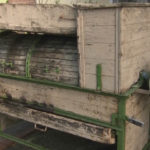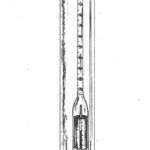Wino jest pokarmem.
Wino jest pokarmem, ponieważ zawiera składniki odżywcze, które dostarczają energii, a przede wszystkim mikroskładniki odżywcze. Aby poznać wartość odżywczą danego pokarmu, bada  się zazwyczaj skład chemiczny dla 100g. W przypadku wina należy przeprowadzić analizę dla 1 litra, a wynik podzielić przez trzy lub dwa. Otrzymamy skład dla 33 ml lub 50 ml, co odpowiada ilości wina zazwyczaj spożywanej każdego dnia. Skład odżywczy wina:- Białko (między 1 a 2 g na litr), niedobór białka w winie jest w części rezultatem klarowania, któremu poddane jest wino podczas wyrobu i który to proces eliminuje większość białek
się zazwyczaj skład chemiczny dla 100g. W przypadku wina należy przeprowadzić analizę dla 1 litra, a wynik podzielić przez trzy lub dwa. Otrzymamy skład dla 33 ml lub 50 ml, co odpowiada ilości wina zazwyczaj spożywanej każdego dnia. Skład odżywczy wina:- Białko (między 1 a 2 g na litr), niedobór białka w winie jest w części rezultatem klarowania, któremu poddane jest wino podczas wyrobu i który to proces eliminuje większość białek
– Węglowodany (w przypadku wina czerwonego ilość pozostałych cukrów (glukozy i fruktozy) = 2-3 g na litr, w przypadku win białych mogą one być liczniejsze do 20 g/l w winach bardzo owocowych, a nawet do 100 g/l w niektórych winach likierowych).
– Tłuszcze (wino nie zawiera tłuszczów). Jedyne ryzyko występuje w związku z nasionami winogron, które po rozgnieceniu mogłyby uwolnić znajdujący się w nich śladowe ilości oleju.
– Błonnik (analizy składu chemicznego nie potrafią wykryć błonnika w winie, mimo iż w rzeczywistości, niektóre włókna winogron są rozpuszczalne i występują w postaci płynnej w winie)
– Woda (1l wina może zawierać różną proporcję wody: 730 ml w winie słodkim, 880 ml w winie białym 11%, 920 ml w Wienie czerwonym 12%.
– Alkohol (średnia proporcja alkoholu wynosi 75 g/l w przypadku wina 9%, 88 g/l dla wina 11%, 96 g/l dla wina 12% i 160 g/l dla wina słodkiego). Poza alkoholem etylowym, wino zawiera małe ilości alkoholu propylowego, butylowego i amylowego, nieznaczna ilość metanolu.
– Sole mineralne: potas (700-1600 mg), wapń (50-200 mg), magnez (50-200 mg), sód (20-250 mg), fosfor (100-200 mg).
– Mikroelementy: żelazo (2-10 mg), miedź (0,2-1 mg), cynk (0,1-5 mg), mangan (0,5-3 mg). Wino może tez zawierać mikroelementy niepożądane: aluminium, ołów, arszenik – jest to rezultatem m.in. spalin wydalanych przez samochody na benzynę ołowiową.
– Witaminy (ilości śladowe B1, B2, B3, B5, B6)
– Polifenole (stężenie wynosi od kilku miligramów w przypadku win białych do 1,2 a nawet 3 g w winach czerwonych)
– Kwasy Organiczne (winowy, jabłkowy i salicylowy)
– Inne Substancje: aldehydy (20mg/l), które z estrami, alkoholami i fenolami, stanowią substancje lotne, odpowiadające za aromaty. Mogą pojawić się substancje mniej pożądane: siarka, histamina, tyra mina, serotonina itd.
 się zazwyczaj skład chemiczny dla 100g. W przypadku wina należy przeprowadzić analizę dla 1 litra, a wynik podzielić przez trzy lub dwa. Otrzymamy skład dla 33 ml lub 50 ml, co odpowiada ilości wina zazwyczaj spożywanej każdego dnia. Skład odżywczy wina:- Białko (między 1 a 2 g na litr), niedobór białka w winie jest w części rezultatem klarowania, któremu poddane jest wino podczas wyrobu i który to proces eliminuje większość białek
się zazwyczaj skład chemiczny dla 100g. W przypadku wina należy przeprowadzić analizę dla 1 litra, a wynik podzielić przez trzy lub dwa. Otrzymamy skład dla 33 ml lub 50 ml, co odpowiada ilości wina zazwyczaj spożywanej każdego dnia. Skład odżywczy wina:- Białko (między 1 a 2 g na litr), niedobór białka w winie jest w części rezultatem klarowania, któremu poddane jest wino podczas wyrobu i który to proces eliminuje większość białek– Węglowodany (w przypadku wina czerwonego ilość pozostałych cukrów (glukozy i fruktozy) = 2-3 g na litr, w przypadku win białych mogą one być liczniejsze do 20 g/l w winach bardzo owocowych, a nawet do 100 g/l w niektórych winach likierowych).
– Tłuszcze (wino nie zawiera tłuszczów). Jedyne ryzyko występuje w związku z nasionami winogron, które po rozgnieceniu mogłyby uwolnić znajdujący się w nich śladowe ilości oleju.
– Błonnik (analizy składu chemicznego nie potrafią wykryć błonnika w winie, mimo iż w rzeczywistości, niektóre włókna winogron są rozpuszczalne i występują w postaci płynnej w winie)
– Woda (1l wina może zawierać różną proporcję wody: 730 ml w winie słodkim, 880 ml w winie białym 11%, 920 ml w Wienie czerwonym 12%.
– Alkohol (średnia proporcja alkoholu wynosi 75 g/l w przypadku wina 9%, 88 g/l dla wina 11%, 96 g/l dla wina 12% i 160 g/l dla wina słodkiego). Poza alkoholem etylowym, wino zawiera małe ilości alkoholu propylowego, butylowego i amylowego, nieznaczna ilość metanolu.
– Sole mineralne: potas (700-1600 mg), wapń (50-200 mg), magnez (50-200 mg), sód (20-250 mg), fosfor (100-200 mg).
– Mikroelementy: żelazo (2-10 mg), miedź (0,2-1 mg), cynk (0,1-5 mg), mangan (0,5-3 mg). Wino może tez zawierać mikroelementy niepożądane: aluminium, ołów, arszenik – jest to rezultatem m.in. spalin wydalanych przez samochody na benzynę ołowiową.
– Witaminy (ilości śladowe B1, B2, B3, B5, B6)
– Polifenole (stężenie wynosi od kilku miligramów w przypadku win białych do 1,2 a nawet 3 g w winach czerwonych)
– Kwasy Organiczne (winowy, jabłkowy i salicylowy)
– Inne Substancje: aldehydy (20mg/l), które z estrami, alkoholami i fenolami, stanowią substancje lotne, odpowiadające za aromaty. Mogą pojawić się substancje mniej pożądane: siarka, histamina, tyra mina, serotonina itd.
Więcej o wyrobie wina domowego znajdziesz na portalu WinoDomowe.info.
Znaleziono w Google poprzez frazy:
- przepis na wino z głogu i winogron
- zawartosc fruktozy w winie bialym







